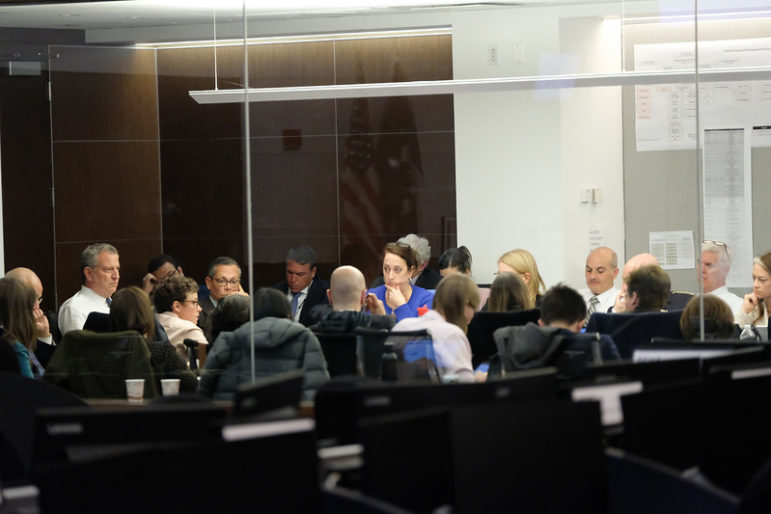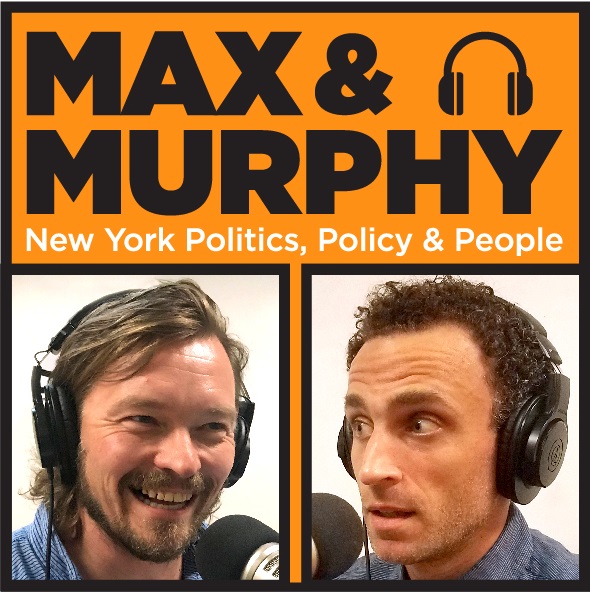
Michael Appleton/Mayoral Photography Office
Mayor de Blasio chairs a tabletop exercise on coronavirus on March 4.Other than washing their hands and following the news, New Yorkers need not adopt more dramatic measures to protect themselves from the coronavirus outbreak–unless the number of cases accelerates, a public-health expert told WBAI’s Max & Murphy Show on Wednesday.
“For me, personally, the magic number in my head right now is if we have 100 cases, because we know that about 2.2. cases result from each case, so I’m thinking in my mind’s eye that if we had 100 cases we have 220 cases and those cases can each infect 2.2 people,” Dr. Robyn Gershon of the School of Global Public Health at New York University said. “At that point I might switch to telecommuting personally. But it’s not there yet. It’s nowhere near there.”
Mark Levine, the chair of the City Council’s health committee, told the program that the Department of Health and Mental Hygiene was considering stronger measures hour to hour.
The Council’s health committee was scheduled to join the committee on hospitals in hosting a Thursday hearing on the city’s response to the virus. The 1 p.m. hearing will be broadcast here.
“I want to emphasize that this question of social distancing—which is the blanket term for telling people to avoid everything from public events to mass transit to schools—is one that the city’s health department is contemplating every minute of every hour and they need to make the right call on when to change their advice to New Yorkers,” Levine told the program.
“We have a world-class public health system. We have, particularly in the area of infectious disease control, some of the top leaders globally,” he added. “The health department and some of the relevant agencies in the city have been prepping for this for weeks. New Yorkers should take comfort in that.”
As of Wednesday night, the local impact of the disease stood well below the number that Gershon said marked the threshold between moderate and more significant danger.
Eleven cases of the virus had been confirmed in New York State–nine more than were known the previous night, but in and of itself, not a large number of illnesses: In 2017, there were 37 cases of Typhoid fever and 229 cases of Malaria in the city alone, although neither disease made headlines.
According to the latest situation report issued by the World Health Organization, there were just over 100 cases of coronavirus throughout the United States. Worldwide, the agency reported 93,000 cases and 3,200 deaths so far, the vast majority of both in China.
To date, the city’s response has consisted of a multiagency public information campaign, the distribution of resources like facemasks and sanitizers to schools, and “disease detective” investigation of known cases. In addition, the school system has stepped up cleaning and cancelled some foreign trips, public hospitals have implemented new screening measures and procedures for dealing with possible COVID-19 cases have been adopted by the 911 system.
Levine noted that, so far, the outbreak did not seem to be affecting children very much—meaning, “it’s probably true that faculty and staff are more at risk in schools than are children.” It’s also true that schools are a vital source of daily needs for families, providing meals and a form of childcare, such that closing schools comes at a very high social cost.
“This is not a decision that can or should be made lightly. But that’s being reevaluated on a constant, hour by hour basis. This is not being taken lightly,” Levine said. “The school system is prepared if we have to move to a new stage.”










2 thoughts on “Evaluating NYC’s Response to Coronavirus: Key Decisions Loom”
You do not want Bill deBlasio involved in this effort in any way. I have severe doubts that his ‘world class’ public health system is anything but incompetent. The large world-class private hospitals and labs of NYC are our best hope. Quest and other labs are already ahead of the city in Coronavrus testing.
https://www.crainsnewyork.com/health-care/quest-and-other-labs-rush-out-coronavirus-tests-next-week
3% death rate means 10 x 30= 300,000 new yorker’s could die
from the corona virus!
Wash your hands is not enough Mr mayor and Governor Cumo!!
do something intelligent like:
Distribute free face mask, gloves, and sanitizer, like china.
Stop understating this health emergency, just so you can sit back and do nothing!!!!!
2) Insist that the CDC and FDA not drag its feet( CDC says 7 to 18 months to release a vaccine!!
3) The genome of the corona virus is well know and has been studied
for 50 years.
4) At least 6 labs announced prototype vaccines this week.
The Governor and mayor should be insisting on the USA and WHO coordinating the testing of these prototype vaccines( otherwise each lab will be reinventing the wheel”)
That’s what would be helpfull. Instead the 3 stooges: trump, cumo
deblazio are saying ” dont worry just wash your hands”.
Do we really want to believe the stooges: MD’s that say mask work
for doctors, but not ordinary peons, like stooge anthony faulchi
head of CDC. and various tv doctors who say just wash your hands.
action to speed up a vacine and action is needed to prevent the
spread of the virus, that means large scale distribution of mask
gloves and sanitizer by the government,
“hospitals are prepared” is a joke, intensive care depts would
be full in 2 weeks, once the number of cases reach a thousand
in nyc.